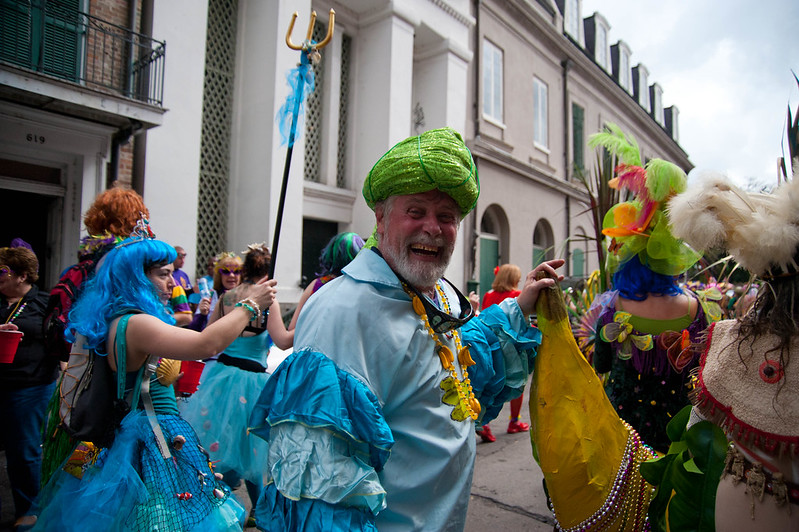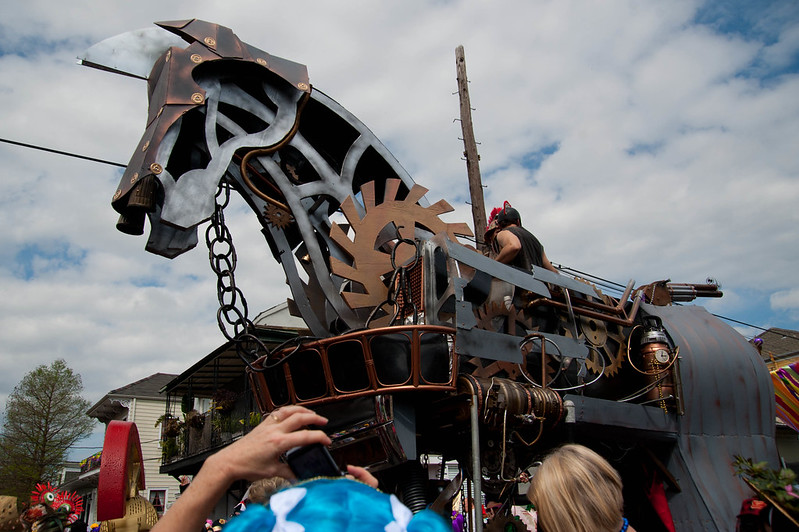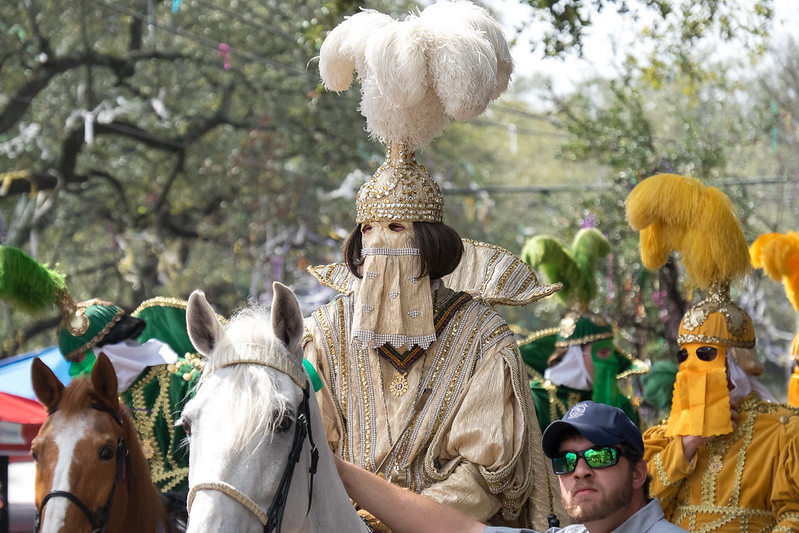New Orleans Mardi Gras
A Kaleidoscope of Culture, Color, and Carnival
2026/02/16
As the sun sets on Bourbon Street, the entire city swells with anticipation. Mardi Gras, the crown jewel of New Orleans' cultural calendar, transforms the city into a whirlwind of vibrant parades, pulsating jazz, and unbridled joy. For two weeks leading up to Fat Tuesday, locals and tourists alike are swept up in the unique atmosphere of the Big Easy. Everyone is captivated by the dazzling festivities. Over a million jubilant people gather, shouting "Laissez les bon temps rouler" (French for "Let the good times roll") as they enjoy the festival in their own way. This phrase truly embodies the spirit of Mardi Gras.
Main Attractions
Spectacular Parades
The heart of Mardi Gras is undoubtedly its parades. The entire city pulsates to their rhythm. Over 80 "krewes" (social organizations) march through the streets, each with its own theme and traditions. The Krewe of Rex, known as the "King of Carnival," captivates onlookers with its intricately crafted floats and regal costumes. As the parade winds through the French Quarter, the city erupts in celebration. The joyous music of brass bands fills the air, while excited cries of "Throw me something, mister!" echo from the sidelines. Costumed riders on the floats toss special Mardi Gras beads, commemorative coins called doubloons, and various trinkets to the enthusiastic crowd. The spectators compete to catch these treasures, further intensifying the festive atmosphere.
Masquerade Balls
The glitterati of New Orleans society gather for lavish masquerade balls. These traditional events are not open to the general public, and behind closed doors, participants in elaborate masks dance gracefully with champagne in hand. The most ancient and mysterious of these is the Mistick Krewe of Comus ball. It transforms the Marriott Hotel into a fantastical space where debutantes in white gowns dance with masked gentlemen to the strains of a live orchestra, creating a scene of picturesque beauty.
Culinary Delights
While Mardi Gras engages all five senses, it's particularly satisfying to the taste buds. The aroma of freshly baked King Cakes wafts through the streets, and bakery windows display colorful cakes dusted with purple, green, and gold sugar. Lucky finders of the small plastic figurine hidden inside the cake are crowned "king" for the day. Street vendors offer fragrant bowls of jambalaya and crispy beignets generously dusted with powdered sugar. Revelers enjoy the festivities with Hurricane cocktails, served in distinctive glasses shaped like hurricane lamps, adding a potent kick to the celebrations.
Cultural and Historical Background
The origins of New Orleans' Mardi Gras can be traced back to March 3, 1699. French-Canadian explorer Pierre Le Moyne d'Iberville set up camp about 60 miles downstream from present-day New Orleans and held a small celebration. This festival is said to have roots in pagan celebrations of spring and fertility held in ancient Rome thousands of years ago.
From around 1703, French soldiers and settlers began enjoying festive events, and the celebration gradually evolved. In 1837, the first recorded street parade took place in New Orleans. Then in 1857, local businessmen formed a secret society called the "Mistick Krewe of Comus" and organized a themed parade with elaborate floats and performers. This transformed Mardi Gras from mere street revelry into a grand, organized celebration.
Over time, Mardi Gras developed into a unique cultural mosaic blending French, African, and American traditions. Today, this festival means more than just entertainment. It is an expression of New Orleans' identity, a symbol of resilience in the face of adversity, and a celebration of life. Even in the wake of disasters like Hurricane Katrina in 2005, Mardi Gras has continued uninterrupted as a testament to the city's unity and determination to preserve its cultural heritage. This festival continues to showcase to the world the resilience of New Orleans' people and their spirit of celebrating life.
Participants Voices
"I've been participating in the Muses parade for 15 years, and it never gets old. Seeing the city come alive, with streets filled with people from all walks of life, is magical. This year, I decorated over 200 glittery shoes to throw from our float. When I saw a little girl's face light up as she caught one, I remembered why we do this every year. Mardi Gras isn't just a party; it's about creating moments of joy and connection."
As a first-time visitor to New Orleans, I was overwhelmed by the energy of Mardi Gras. The city was bursting with color, music was everywhere, and everyone was smiling and having fun - it was truly exhilarating. I joined a parade where a local taught me how to shout "Throw me something, mister!" in a New Orleans accent. I thought the pronunciation was so cool that I practiced it over and over. After walking around all day, I found myself covered in beads. Plus, I made friends with people from all over the world. It was unlike any festival I've ever experienced. Mardi Gras felt like more than just a celebration - it felt like a special time to celebrate life itself.
Mardi Gras has been an important family tradition for generations. I grew up hearing stories about the grand parades and lavish balls. This year, I finally took my own children to see the Zulu parade. It was impressive to see their eyes widen as the warriors on horseback passed by. The joy on their faces when they caught coconuts painted with intricate designs was unforgettable! In that moment, seeing Mardi Gras through my children's eyes, I was enchanted by its magic too. It felt like I was a child again. This festival means more than just an event. It's a precious opportunity to pass on our culture, history, and deep love for New Orleans to the next generation. Through Mardi Gras, I can feel our traditions being carried on, generation after generation.
Fun Facts
- The official Mardi Gras colors - purple (justice), green (faith), and gold (power) - were chosen in 1872 to honor Russian Grand Duke Alexis Romanoff during his visit to New Orleans.
- It is illegal to ride on a float without a mask in New Orleans during Mardi Gras.
- The Mardi Gras Indians, African American tribes who have been an important part of the celebration since the 1800s, create stunning hand-sewn costumes that blend Native American and African traditions.
- The longest-running New Orleans Mardi Gras parade is the Krewe of Rex, which has rolled every year since 1872, except during World Wars I and II.
Festival Dates
Mardi Gras is a moveable feast, with its date determined by the Easter calendar. The Carnival season always begins on January 6 (Epiphany) and culminates on Fat Tuesday, the day before Ash Wednesday.
The event schedule is subject to change. Please check the official website for the most up-to-date information.
Information
| Name | New Orleans Mardi Gras |
| Country | United States |
| Area | Louisiana, New Orleans |
| Date | 2026/02/16 |
| Link |
Upcoming Festivals
Whirling Dervishes Festival Turkey
A Mesmerizing Dance of Divine Love
2025/12/06Mevlana Celaleddin Rumi Commemoration Ceremony ( Şeb-i Arus ) Turkey
A Whirling Journey to Divine Love
2025/12/10Dia de la Virgen de Guadalupe Mexico
A Festival Weaving Faith, Fervor, and Mexican Identity
2025/12/11L'Escalade Switzerland
Geneva’s Grand Winter Festival of Courage, Chocolate, and Community
2025/12/12Umkhosi Wokweshwama South Africa
The Zulu First Fruits Festival—A Sacred Celebration of Land, Ancestors, and Renewal
2025/12/12Lucia Festival (St. Lucia's Day) Sweden
A Festival of Light Illuminating the Nordic Darkness
2025/12/15Las Posadas Mexico
The Luminous Quest for Sacred Shelter
2025/12/22Noche de Rabanos (Night of the Radishes) Mexico
A celebration blending art, farming heritage, and cultural traditions
2025/12/23Chant of the Sybil on Majorca Spain
A Medieval Prophecy Echoes Through Majorcan Christmas
2025/12/23‘Hatajo de Negritos’ and the ‘Hatajo de Pallitas’ Peru
A Christmas Festival of Rhythm, Faith, and Afro-Andean Heritage in Peru’s Ica Region


